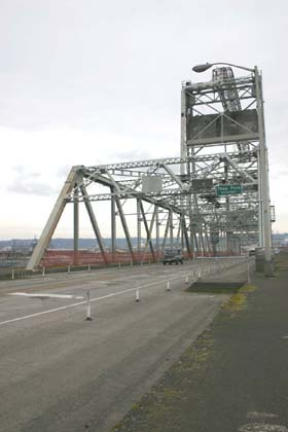The Tacoma City Council may draw a resolution to direct City Manager Jim Walton to negotiate an agreement with the Washington State Department of Transportation to take ownership of the historic Murray Morgan Bridge, according to a council study session yesterday.
If a resolution is created and approved by the council, the city would receive $25.6 million from WSDOT and ownership of the historic bridge, which is named after the late writer and Tacoma native Murray Morgan.
This is the day and time to move forward, said councilmember Thomas Stenger, who is also a founder of the Tacoma Historical Society. This is a very exciting, can-do project. Stenger urged councilmembers to draw a resolution at the meeting, clearly showing his support and enthusiasm for the project.
Indeed, while several councilmembers and the mayor showed support for owning and operating the bridge, a key concern is the cost to repair, operate and maintain the structure, which was built in 1913.
According to consultants tasked with examining the costs and issues of owning the bridge, the structure faces risks due to its age and seismic integrity.
Dave Moyano, director of bridge engineering and senior vice president at David Evans and Associates, a design firm hired to make recommendations about the bridges condition, reported that the structure would be unsafe for service by 2010. WSDOT has expressed concerns over the safety of the bridge. Two years ago, the department announced plans to demolish the bridge in 2006.
Should the city pursue ownership of the bridge, it would also inherit a bill for repairs that ranges between $3 million (the cost of seismically retrofitting a portion of the structure) and $135 million (the cost of demolishing and replacing the bridge). Repairs would also shut down traffic along the bridge anywhere from 18 to 36 months.
I cant support a resolution at this time, said Deputy Mayor Connie Ladenburg. She indicated support for saving the bridge, but wanted to explore bargaining options with WSDOT. Twenty-five million dollars is a fraction of the cost of demolishing and replacing the bridge, she said. Its an easy out for the Department of Transportation. Ladenburg expressed an interest in identifying sources of funding and perhaps bargaining with WSDOT to receive more money to take ownership of the bridge.
Moyano illustrated the bridges needs in several work package alternatives, each with varying costs. He also made a distinction between rehabilitating the bridge (replacing existing portions of the bridge with new materials) and restoring (fixing the bridge in a manner sensitive to the original structure and its materials).
The council expressed initial interest in two specific work packages.
The first package, which costs $80 million and closes the bridge for 30 months, calls for full rehabilitation of the bridge, replacement of the deck, new paint, and seismic work to the structure.
The other package, which costs $77 million and closes the bridge for 30 months, calls for full restoration of the bridge, west ramp, and lift-span operational systems.
The cost to restore or rehabilitate the bridge is only one part of the decision to take ownership of the bridge. Another issue is bridges annual operation and maintenance, which is estimated to cost $440,000 annually.
Consultant David Allen provided the council with opportunities and ideas to fund repairs, operation and maintenance of the bridge. He encouraged the city council and mayor to view the bridge as an important part of Tacomas economic development plans. The purpose of the original bridge was to provide access from downtown Tacoma to the Port and tide flats, Allen said. It served as a busy industrial access corridor throughout the 20th century. The bridge is no longer an industrial arterial, but it will play a new and far more important role in the 21st century. It promises to become the vital commercial and business connection for downtown Tacomas central business district.
Such a view, said Allen, might result in urban corridor funding from the Washington State Transportation Improvement Board.
Allen also suggested replacing the west ramp with a parking garage. The garages roof would be level to the bridge deck, providing access for motorists and pedestrians; revenue from the garage would help fund repairs to the bridge. He also suggested that benches, signs, lamp posts, and other amenities sponsored by the private sector could also provide funds.
A bridge across Tacomas westernmost span of the Thea Foss Waterway has seen many incarnations.
In 1895, the City of Tacoma sold $100,000 in bonds to fund what was then called the Eleventh Street Bridge — an ungodly sum that drew criticism from Tacoma residents.
Almost two decades later, the bridge was demolished.
In its place rose an architectural wonder of its time. The new Eleventh Street Bridge (also called the City Waterway Bridge), which opened Feb. 15, 1913, cost $600,000 — a price tag that quickly earned its reputation as one of the most expensive bridges west of Chicago. The structure consisted of nearly 3,000 tons of steel, more than 13,000 yards of concrete, and spanned more than 1,700 feet east to west.
To its credit, the design was innovative. Its vertical-lift truss allowed the bridge deck to lift, which provided easy passage for ships in and out of the waterway. It was also the only vertical lift bridge built on an incline (the bridge slopes two-and-one-half percent from west to east).
The bridge is linked to the writer Murray Morgan. Historians note that Morgan worked as a bridge tender while he wrote Skid Road, the history of Seattle through the 1930s. On May 21, 1997, the bridge was renamed the Murray Morgan Bridge.
The city has nothing to lose by moving forward and directing the city manager to negotiate with the Department of Transportation, said Dawn Lucien, a former Tacoma city councilmember, and proponent of Save Our Bridge, a group that supports restoration and rehabilitation of the structure. I hope a resolution is passed.










